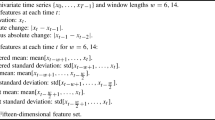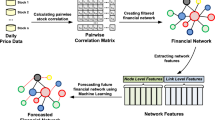Abstract.
We study the activity of financial markets, i.e., the number of transactions per unit of time. Using the diffusion entropy technique we show that the autocorrelation of the activity is caused by the presence of peaks whose time distances are distributed following an asymptotic power-law which ultimately recovers an exponential behavior. We discuss these results in comparison with ARCH models, stochastic volatility models and multi-agent models showing that ARCH and stochastic volatility models better describe the observed experimental evidences.
Similar content being viewed by others
References
In other works the activity is defined as the number of transactions per unit of time weighted with the corresponding volume (see for instance Ref. [2]). In this paper we focus on the properties of the transaction frequency, i.e., the number of transactions per unit time regardless the volume. In any case and for simplicity we will use the terms activity and transaction frequency without distinction
M.M. Dacorogna, R. Gençay, U.A. Müller, R.B. Olsen, O.V. Pictet, An Introduction to High-Frequency Finance (Academic Press, San Diego, 2001)
R.F. Engle, Econometrica 61, 987 (1982)
J.P. Fouque, G. Papanicolaou, K. Ronnie Sircar, Derivatives in Financial Markets with Stochastic Volatility (Cambridge University Press, Cambridge, UK, 2000)
J. Perelló, J. Masoliver, Phys. Rev. E 67, 037102 (2003)
P.G. Andersen, J. Finance L1, 1 (1996)
W.A. Brock, B.D. LeBaron, Rev. Econom. Stat. 78, 94 (1996)
J.P. Bouchaud, I. Giardina, M. Mézard, Quant. Fin. 1, 212 (2001)
J.P. Bouchaud, I. Giardina, Physica A 324, 6 (2003); I. Giardina, J.P. Bouchaud, M. Mézard, Physica A 299, 28 (2001)
G. Iori, J. Econom. Behav. Organiz. 49, 269 (2002)
F. Mainardi, M. Raberto, R. Gorenflo, E. Scalas, Physica A 287, 468 (2000)
L. Sabatelli, S. Keating, J. Dudley, P. Richmond, Eur. Phys. J. B 27, 273 (2002)
J. Masoliver, M. Montero, G.H. Weiss, Phys. Rev. E 67, 021112 (2003)
W. Feller, Trans. Am. Math. Soc. 67, 98 (1949)
P. Grigolini, L. Palatella, G. Raffaelli, Fractals 9, 439 (2001)
M.S. Mega, P. Allegrini, P. Grigolini, V. Latora, L. Palatella, A. Rapisarda, S. Vinciguerra, Phys. Rev. Lett. 90, 188501 (2003)
T. Lux, M. Marchesi, Nature 397, 498 (1999); Int. J. Theo. Appl. Fin. 3, 675 (2000)
N. Platt, E.A. Spiegel, C. Tresser, Phys. Rev. Lett. 70, 279 (1993); N. Platt, S.M. Hammel, J. F. Heagy, Phys. Rev. Lett. 72, 3498 (1994)
R.F. Engle, A.J. Patton, Quant. Fin. 1, 237 (2001)
J. Masoliver, J. Perelló, Int. J. Theo. Appl. Fin. 5, 541 (2002)
P. Allegrini, P. Grigolini, P. Hamilton, L. Palatella, G. Raffaelli, Phys. Rev. E 65, 041926 (2002)
P. Allegrini, R. Balocchi, S. Chillemi, P. Grigolini, L. Palatella, G. Raffaelli, in ISMDA 2002, Lecture Notes Computer Sciences 2526, “Medical Data Analysis”, edited by A. Colosimo et al. (Springer-Verlag, Berlin, Heidelberg, 2002), p. 115
P. Allegrini, R. Balocchi, S. Chillemi, P. Grigolini, P. Hamilton, R. Maestri, L. Palatella, G. Raffaelli, Phys. Rev. E 67, 062901 (2003)
The data was provided by the The Institute for Financial Markets and consist of transaction prices. We use the data of the closest-to-maturity contract. Since we do not know the exact expiration date, i.e., the last traded day for each contract, we have discarded some usable data, in the period comprised between the expiration day and the end of the month. We also analyse a different prescription consisting on switching between contracts at the very beginning of the maturity month, obtaining identical results. We use the most usual roll-over procedure consisting in a backward correction of the previous prices. This technique is intended to correct the gap that usually exists between the last traded price of the old contract, and the first traded price of the new one the following morning. We do not perform any outlier correction. Regarding overnight dynamics we do not know whether nights and days follow the same dynamics, or whether ordinary nights and weekends are equivalents. Thus we use the simplest approach and neglect those periods of time for which we have no data
We have checked numerically that this hypothesis should not be considered as a real constraint. Even in the case that the typical time duration of a peak is comparable with the distance between peaks, the condition required in DE technique for obtaining the correct asymptotic scaling is that \(t\gg\langle\tau_c\rangle\)
This periodic behavior can be easily singled out by a fast Fourier transform of the FX data
In the original model there is a mean drift in the return corresponding to the mean growth of the market. Our data correspond to a FX market where this effect is not present. Therefore, there is no mean drift in our analysis
J. Perelló, J. Masoliver, J.-P. Bouchaud, Appl. Math. Fin. 11, 27 (2004)
A. Krawiecki, J.A. Hołyst, D. Helbing, Phys. Rev. Lett. 89, 158701 (2002)
Author information
Authors and Affiliations
Corresponding author
Additional information
Received: 15 March 2004, Published online: 8 June 2004
PACS:
89.65.Gh Economics; econophysics, financial markets, business and management - 05.45.Tp Time series analysis - 05.40.-a Fluctuation phenomena, random processes, noise, and Brownian motion
Rights and permissions
About this article
Cite this article
Palatella, L., Perelló, J., Montero, M. et al. Activity autocorrelation in financial markets. Eur. Phys. J. B 38, 671–677 (2004). https://doi.org/10.1140/epjb/e2004-00161-6
Issue Date:
DOI: https://doi.org/10.1140/epjb/e2004-00161-6




